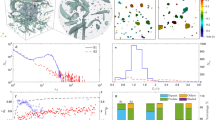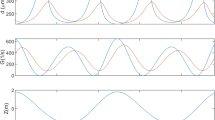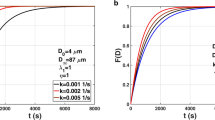Abstract
Both the floc formation and floc breakup of cohesive sediment are affected by turbulent shear which is recognized as one of the most important parameters, and thus, on the settling and transport of cohesive sediment. In this study, the development of floc characteristics at early stage and steady-state of flocculation were investigated via a three-dimensional lattice Boltzmann numerical model for turbulence-induced flocculation. Simulations for collision and aggregation of various size particles, floc growth, and breakup in isotropic and homogenous turbulent flows with different shear stresses were conducted. Model results for the temporal evolution of floc size distribution show that the normalized floc size distributions is time-independent during early stage of flocculation, and at steady-state, shear rate has no effect on the shape of normalized floc size distribution. Furthermore, the size, settling velocity, and effective density of flocs at the non-equilibrium flocculation stage do not change significantly for shear stresses in the range 0–0.4 N m−2. The relationships between floc size and settling velocity established during floc growth stages and that during steady-states are different.















Similar content being viewed by others
References
Amos CL, Droppo IG (1996) The stability of remediated lake bed sediment, Hamihon Harbour, Lake Ontario, Canada. Geological Survey of Canada Open File Report. 2276
Amos CL, Umgiesser G, Ferrarin C, Thompson CEL, Whitehouse RJS, Sutherland TF, Bergamasco A (2010) The erosion rates of cohesive sediments in Venice lagoon, Italy. Cont Shelf Res 30:859–870
Camp TR, Stein PG (1943) Velocity gradients and internal work in fluid motion. J Boston Soc Eng 30:219–237
Cate AT, Derksen JJ, Portela LM (2004) Fully resolved simulations of colliding monodisperse spheres in forced isotropic turbulence. J Fluid Mech 519:233–271
Chen H, Chen S, Matthaeus WH (1992) Recovery of the Navier–Stokes equations using a lattice-gas Boltzmann method. Phys Rev A 45:R5339–R5342
Chen S, Doolen GD (1998) Lattice Boltzmann method for fluid flows. Annu Rev Fluid Mech 30:329–364
Frappier G, Lartiges BS, Skali-Lami S (2010) Floc cohesive force in reversible aggregation: a Couette laminar flow investigation. Langmuir 26(13):10475–10488
Ha HK, Maa JPY (2010) Effects of suspended sediment concentration and turbulence on settling velocity of cohesive sediment. Geosci J 14(2):163–171
Hamaker HC (1937) The London–van der Waals attraction between spherical particles. Physica 4(10):1058–1072
Hiemenz PC (1986) Principles of colloid and surface chemistry. New York
Higashitani K, Iimura K (1999) Two-dimensional simulation of the breakup process of aggregation in shear and elongational flows. J Colloid Interface Sci 204:320–327
Higashitani K, Iimura K, Sanda H (2001) Simulation of deformation and breakup of large aggregates in flows of viscous fluids. Chem Eng Sci 56:2927–2938
Hill RJ, Koch DL, Ladd AJC (2001) The first effects of fluid inertia on flows in ordered and random arrays of spheres. J Fluid Mech 448:213–241
Huang H (1994) Fractal properties of flocs formed by fluid shear and different settling. Phys Fluids 36(10):3229–3234
Hunt JR (1982) Self-similar particle-size distributions during coagulation: theory and experimental verification. J Fluid Mech 122:169–185
Kim S, Karrila SJ (1991) Microhydrodynamics: principles and selected applications. Butterworth-Heinemann, Boston
Ladd AJC (1994) Numerical simulations of particulate suspensions via a discretized Boltzmann equation. Part 1. Theoretical foundation. J Fluid Mech 271:285–309
Ladd AJC, Verberg R (2001) Lattice-Boltzmann simulations of particle-fluid suspensions. J Stat Phys 104:1191–1251
Lee DG, Bonner JS, Garton LS, Ernest ANS, Autenrieth RL (2000) Modeling coagulation kinetics incorporating fractal theories: a fractal rectilinear approach. Water Res 34(7):1987–2000
Li XY, Logan BE (1997) Collision frequencies between fractal aggregates and small particles in turbulently sheared fluid. Environ Sci Technol 31:1237–1242
Liebovitch LS, Toth T (1989) A fast algorithm to determine fractal dimensions by box counting. Phys Lett A 141(8–9):386–390
Liu QZ, Li JF, Dai ZJ, Li DJ (2007) Flocculation process of fine-grained sediments by the combined effect of salinity and humus in the Changjiang Estuary. Acta Oceanol Sin 26(1):140–149
Lundgren TS (2003) Linearly forced isotropic turbulence. Annual Research Briefs. 461–473
Machiels L (1997) Predictability of small-scale motion in isotropic fluid turbulence. Phys Rev Lett 79(18):3411–3414
Maggi F (2005) Flocculation dynamics of cohesive sediments. Dissertation, Delft University of Technology
Maggi F, Mietta F, Winterwerp JC (2007) Effect of variable fractal dimension on the floc size distribution of suspended cohesive sediment. J Hydrol 343(1–2):43–55
Manning AJ (2004) The observed effects of turbulence on estuarine flocculation. J Coast Res 41:90–104, SI
Manning AJ, Dyer KR (1999) A laboratory examination of floc characteristics with regard to turbulent shearing. Mar Geol 160:147–170
Manning AJ, Friend PL, Prowse N, Amos CL (2007) Estuarine mud flocculation properties determined using an annular mini-flume and the LabSFLOC system. Cont Shelf Res 27:1080–1095
McCave IN (1984) Size spectra and aggregation of suspended particles in the deep ocean. Deep-Sea Res 31(4):329–352
Mietta F, Chassagne C, Manning AJ, Winterwerp JC (2009) Influence of shear rate, organic matter content, pH and salinity on mud flocculation. Ocean Dyn 59:751–763
Nguyen NQ, Ladd AJC (2002) Lubrication correction for lattice-Boltzmann simulations of particle-fluid suspensions. Phys Rev. E66: 046708-1–11
Russel WB, Saville DA, Schowalter WR (1989) Colloidal dispersions. Cambridge University Press, Cambridge
Smoluchowski M (1917) Versuch einer mathematischen theorie der koagulations-kinetik kolloider losunge. Z Phys Chem 92:129–168
Spicer PT, Pratsinis SE (1996) Shear-induced flocculation: the evolution of floc structure and the shape of the size distribution at steady state. Water Res 30(5):1049–1056
Tang S, Ma Y, Shiu C (2001) Modeling the mechanical strength of fractal aggregates. Colloids Surf A Physicochem Eng Asp 180(1):7–l6
Verway EJ, Overbeek JTG (1948) Theory of the stability of hyophobic colloids. Elsevier, Amsterdam
Winterwerp JC (1998) A simple model for turbulence induced flocculation of cohesive sediment. J Hydraul Res 36(3):309–326, IAHR
Winterwerp JC, Manning AJ, Martens C, de Mulder T, Vanlede J (2006) A heuristic formula for turbulence-induced flocculation of cohesive sediment. Estuarine Coastal Shelf Sci 68:195–207
Xu FH, Wang DP, Riemer N (2008) Modeling flocculation processes of fine-grained particles using a size- resolved method: comparison with published laboratory experiments. Cont Shelf Res 28:2668–2677
Yan P, Wei L, Luo LS, Wang LP (2010) Comparison of the lattice Boltzmann and pseudo-spectral methods for decaying turbulence: low-order statistics. Comput Fluids 39:568–591
Zeidan M, Xu B, Jia X (2007) Simulation of aggregate deformation and breakup in simple shear flows using a combined continuum and discrete model. Chem Eng Res Des 85(12):1645–1654
Zhang JF, Zhang QH (2009) Hydrodynamics of fractal flocs during settling. J Hydrodyn 21(3):347–351
Zhang JF, Zhang QH (2011) Lattice Boltzmann simulation of the flocculation process of cohesive sediment due to differential settling. Cont Shelf Res 31:S94–S105
Zhang QH, Zhang JF (2007) Modeling of 3D fractal mud flocs settling via lattice Boltzmann method. In: Sediment and Ecohydraulics - Proc. in Marine Science, INTERCOH 2005. Elsevier, Amsterdam
Acknowledgments
Whoever supported the early stage of this manuscript should also be acknowledged. The revision of this manuscript during the period of the first author’s visiting at the Virginia Institute of Marine Science, College of William and Mary, was supported by the National Natural Science Foundation of China (Grant no. 50909071) and the Science Fund for Creative Research Groups of the National Natural Science Foundation of China (Grant No. 51021004).
Author information
Authors and Affiliations
Corresponding author
Additional information
Responsible Editor: Andrew James Manning
This article is part of the Topical Collection on the 11th International Conference on Cohesive Sediment Transport
Rights and permissions
About this article
Cite this article
Zhang, JF., Zhang, QH., Maa, J.PY. et al. Lattice Boltzmann simulation of turbulence-induced flocculation of cohesive sediment. Ocean Dynamics 63, 1123–1135 (2013). https://doi.org/10.1007/s10236-013-0646-9
Received:
Accepted:
Published:
Issue Date:
DOI: https://doi.org/10.1007/s10236-013-0646-9




